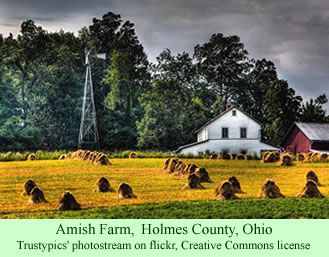Amish farmers in Ohio are effectively modifying their farming practices to cope with changing global climate conditions.
 The Amish “are very well read,” said Dale Arnold, who is the director of energy policy for the Ohio Farm Bureau. “They’re adapting and doing things with hybrids and tiling and sub-surface drainage,” he added. It’s their way of dealing with the problems caused by the changing climate.
The Amish “are very well read,” said Dale Arnold, who is the director of energy policy for the Ohio Farm Bureau. “They’re adapting and doing things with hybrids and tiling and sub-surface drainage,” he added. It’s their way of dealing with the problems caused by the changing climate.
Mr. Arnold, who is also a member of the Ohio Climate Change Dialogue Group, added that a major issue for both Amish and non-Amish farmers in the state is keeping water in the soil. Because of the vagaries of climate change, several summers of drought may be followed by rainy seasons. “Amish farms have bought into agricultural drainage in a big way,” he says.
A news article from Ohio last week explored the ways both Amish and English farmers are coping with climate change issues. One of the major differences between the two groups is that the Amish are limited to what they can do with their small-scale technologies. Dean Slates, a program assistant for the Soil and Water Conservation District in Holmes County, explained that Amish farmers do as much as they can, but they work on a small scale compared to the big farming operations.
“If something requires a lot of dollars to adopt, that’s a problem for them” he said. “Technology that requires large outlays is problematic. They don’t have thousands of acres to spread the cost of the technology. Their power requirements for technology are limited to what a horse can do.”
A news report earlier in 2013 described the advanced agricultural practices adopted by an Amish farmer in Pennsylvania, and it appears as if the Ohio Amish are also adopting the latest techniques, despite their reputation for being resistant to technological changes.
But like every other segment of the population, the Amish are not unified in their thinking about global climate change, according to Mr. Arnold. In fact, they do not necessarily agree that the climate is actually changing. Whatever they may think, they all have to cope with the shifting, and sometimes adverse, weather conditions.
Last year, two researchers in the Ohio Agricultural Research and Development Center in Wooster, part of the Ohio State University, conducted a survey and found that 83 percent of the Amish respondents felt that there was not enough evidence to support a conclusion that the climate is actually changing. In contrast, 47 percent of non-Amish groups agreed that the climate is changing. The researchers admitted, however, that they had only 12 Amish responses to their survey.
Mr. Arnold summarized, for both the skeptics and the believers in climate change, that “there will always be traditional cycles of drought and rain. The issue is how we can adapt through technology for planting and husbandry to strike that balance.”